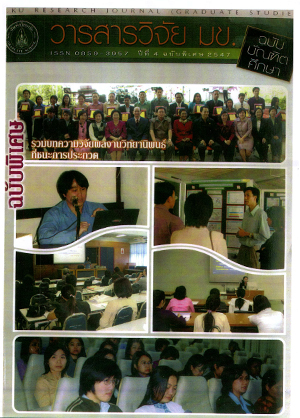ความเป็นไปได้ในการผลิตเม็ดพันธุ์งาลูกผสมเพื่อการค้า (Possibility of Hybrid Seeds Production of Sesame for Commercial Scale)
Keywords:
sesame (Eseamum indicum L.), hybrid sesame, seed production,Abstract
การปรับปรุงพันธุ์งาลูกผสมเป็นทางเลือกหนึ่งที่น่าสนใจในการเพิ่มผลผลิตงาให้สูงขึ้น เนื่องจากพันธุ์ลูกผสมจะมีความดีเด่นที่เหนือกว่าพ่อหรือแม่ที่ดี ซึ่งค่าความดีด่นนี้จะปรากฎเฉพาะในลูกผสมชั่วที่ 1 เท่านั้น โดยคู่ผสมที่ดีจะให้ลูกผสมที่มีผลผลิตสูงและมีความสม่ำเสมอของลักษณะ การทดลองครั้งนี้จะมีวัตถุประสงค์เพื่อศึกษาความเป็นไปได้ในการผลิตเมล็ดลูกงาผสมเพื่อการค้า โดยทำการศึกษาต้นทุนการผลิตเมล็ดพันธุ์ลูกผสมเปรียบเทียบกับงาพันธุ์แท้ รวมทั้งเปรียบเทียบผลผลิตและรายได้จากการใช้งาลูกผสมกับงาพันธุ์แท้ โดยทำการทดลองที่หมวดพืชไร่ คณะเกษตรศาสตร์ มหาวิทยาลัยขอนแก่น ในปี 2544 ทำการผลิตเมล็ดพันธุ์งาลูกผสมพร้อมกับศึกษาต้นทุนการผลิตเมล็ดพันธุ์ และในปี 2545 ได้ทำการทดสอบผลผลิตของงาพันธุ์ลูกผสม 5 คู่ คือคู่ผสมระหว่าง KKU 1 x MR13 KKU 2 x UB1 MR13 x KKU 2 BU1 x MR13 และ MR13 x MK60 เปรียบเทียบกับงาพันธุ์แท้ 5 พันธุ์ คือ KKU 1 KKU 2 MR13 MK60 และ UB1 (พันธุ์ตรวจสอบ) โดยวางแผนการทดลองแบบ RCB มี 4 ซ้ำ ใช้ระยะปลูก 50x10 ซม. มี 6 แถว ยาวแถวละ 5 เมตร ผลการทดลองพบว่างาพันธุ์ลูกผสมให้ผลผลิตสูงกว่างาพันธุ์แท้อย่งมีนัยสำคัญยิ่งทางสถิติ โดยงาพันธุ์แท้และพันธุ์ลูกผสมให้ผลเฉลี่ย 298 และ 456 กก.ต่อไร่ ตามลำดับ อย่างไรก็ตามต้นทุนในการผลิตเมล็ดพันธุ์งาลูกผสมนั้นสูงกว่าต้นทุนการผลิตเมล็ดงาพันธุ์แท้ กล่าวคือ ต้นทุนการผลิตเมล็ดงาพันธุ์แท้เฉลี่ยเท่ากับ 39 บาทต่อ กก. ส่วนต้นทุนการผลิตเมล็ดพันธุ์งลุกผสมเฉลี่ย 465 บาทต่อกก. สไรับลูกผสมที่ให้ผลผลิตสูงสุดคือคู่ผสมระหว่าง KKU1 x MR13 (485 กก.ไร่) ซึ่งสูงกว่าพันธุ์ตรวจสอบ 63.9 เปอร์เซ็นต์ อย่างไรก็ตามต้นทุนการผลิตเมล็ดพันธุ์ลูกผสมคู่นี้ก็สูงที่สุดเช่นเดียวกัน (555 บาทต่อกก.) การศึกษาครั้งนี้พบว่าการใช้พันธุ์งาลูกผสมสามารถทำกำไรสุทธิสูงสุดถึง 5,591 บาทต่อไร่ แสดงให้เห็นว่าการใช้เมล็ดพันธุ์งาลูกผสมคุ้มค่ากับการลงทุนดังนั้นพันธุ์งาลูกผสมจึงเป็นทางเลือกหนึ่งที่น่าสนใจในการเพ่มผลผลิตงาต่อพื้นที่ให้สูงขึ้นได้
Using nybrid variety is one viable alternative to increase crop yield. Because some hybrid varieties show heterobeltiosis and will only appear in F1 generation. Some hybrid varieties will show good agronomic traits such as higth yield with uniformity. The objective of this experiment was to study the possibility of producing hybrid seeds of sesame for commercial scale. Comparisous of production cost of hybrid seeds, yield of hybrid and pure line varieties and income receive from hybrid and pure line varieties were carried out at the Experiment Farm, Department of Agronnomy, Facluty of Agricultrue, Khon Kaen University. The production cost of hybrid seeds was studied in 2001 and yield comparison between hybrid and pure line varieties were studies in 2002. An experimental design was RCB with 4 replications, there were 6 row plot, 5 m. lenght with 50 x 10 cm. Of row x plant spacing. Five hybrid varieties i.e. KKU 1 x MR13 KKU 2 x UB1 MR13 x KKU 2 BU1 x MR13 และ MR13 x MK60 and 5 pure line varieties i.e. KKU 1 KKU 2 MR13 MK60 and UB1 (chack variety) were included in this trial. The results revealed that hybrid varieties gave higher yield than pure lines varieties (456 and 298 kg/rai, respectively). however, the production cost of hybrid varieties are also higher than that of pure line varieties (465 and 39 Baht/kg, resectivety). The higher yield received from the hybrid between KKU1 x MR13 which yielded 485 kg/rai (63.9 % higher than check varuety) whereas the production cost from this hybrid is also the highest one (555 Bath/kg). This study showed hight benefit from usinf=g hybrid varieties (up to 5,591 Bath/rai). Therefore hybrid variety is aviable way increase sesame yield.


